Life Process
Life Process is the important Chapter of Biology that covers complete syllabus of Class 10 giving basic idea of nutrition of unicellular and human being, respiratory system, circulatory and Excretory system.
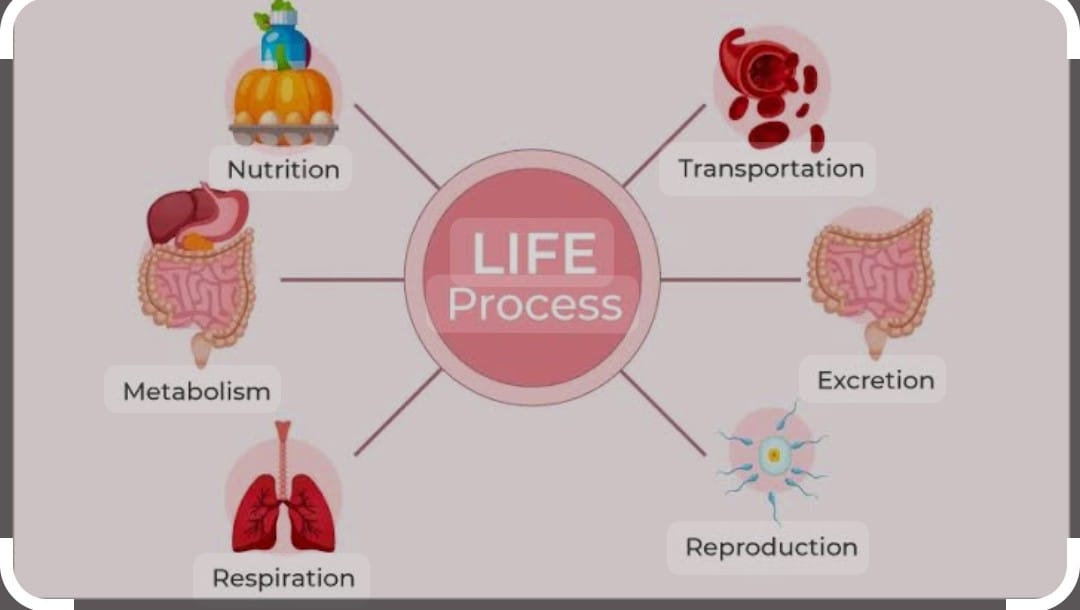
Nutrition
Nutrition is the process of obtaining and utilising food. There are two mode of nutrition a) Autotropic mode of nutrition b) Heterotopic mode of nutrition.
Autotropic Nutrition is the of nutrition in which organism can make their own food from simple raw material eg all green plants.
Heterotrophic Nutrition is the mode of nutrition in which organism cannot make it’s food and have to depend upon others such as animals.
there are different types of Heterotrophs a) Saprotrophic in this organism feed on dead and decaying organism such as Rhizopus. b) Symbiotic in which two organisms live in close relationship in which both are benefited such as lichen is living partnership between a fungus and alga in which fungus absorbs water and provides shelter whereas alga prepare food by photosynthesis. c)Insectivores in which plant feed on insects for their nitrogen requirement)Holozoic Nutrition this means feeding on solid food. The organism takes complex organic food into the body such as man amoeba and dog.
Herbivores are those animals which feed on plants example deer cow
Carnivores are those animals which feed on flesh example tiger
Omnivores are those animals which feed on both plants and flesh example man dog
Autotropic Nutrition
It is the process in which green plants and some bacteria take carbon di oxide and water and convert into carbohydrate in the presence of sunlight and chlorophyll this is called photosynthesis.
6CO2 + 12 H2O———-> sunlight and chlorophyll —-> C6H12O6 +6O2 +6H2O
Raw material for photosynthesis are
a. Sunlight from sun
b. Chloroplast which helps to absorb the sunlight.
c. Cabon. Di Oxide that enters leaf from air through stomata
d. Water is absorbed by roots in soil.
Photosynthesis takes place at chloroplast in the leaf which is green pigment called chlorophyll.
The main events of photosynthesis are
a. Absorption of light energy by chlorophyll this light energy changes to chemical energy than after water is split into hydrogen and oxygen reduction of carbon di oxide to carbohydrates.
Stomata are the tiny pores present on the surface of leaf it’s main function is to exchange gases of CO2 and O2 by the process of diffusion.
b Transpiration is the process which is loss of amount of water.
Stomata consist of guard cells which help in opening and closing of stomata pores water flow in guard cells which swell and water flow out from the guard cells through transpiration than it closes.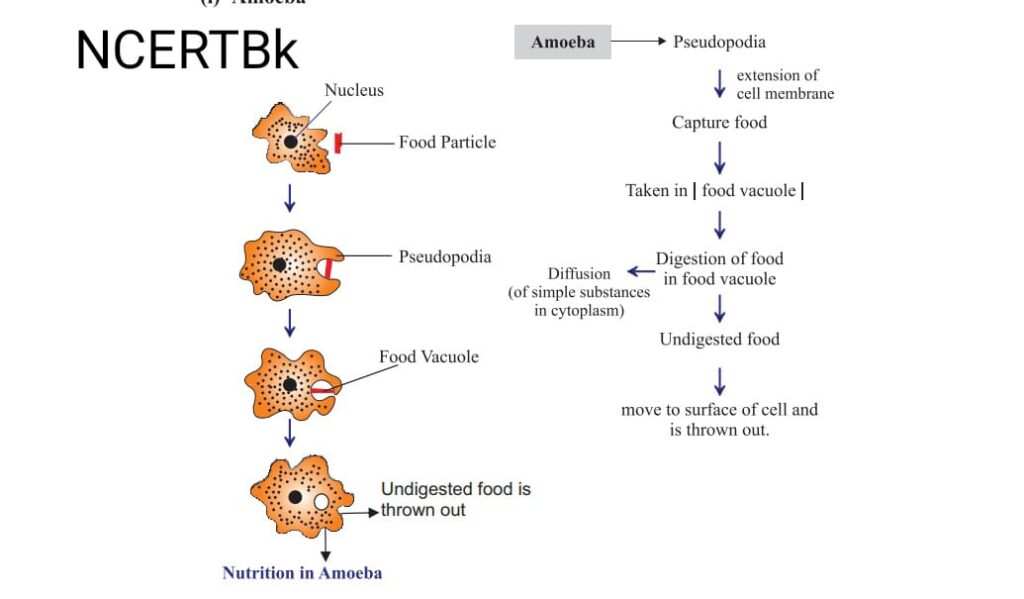
Nutrition in Unicellular Organism
The food is taken up by the entire surface. Amoeba ingestion of food using temporary finger like projection called Pseudopodia but Paramecium uses cila to move towards food at the specific spot to take food in by trapping it with finger like projection form the food vacuole digest it and than eject out as waste. from ncert b
Nutrition In Human being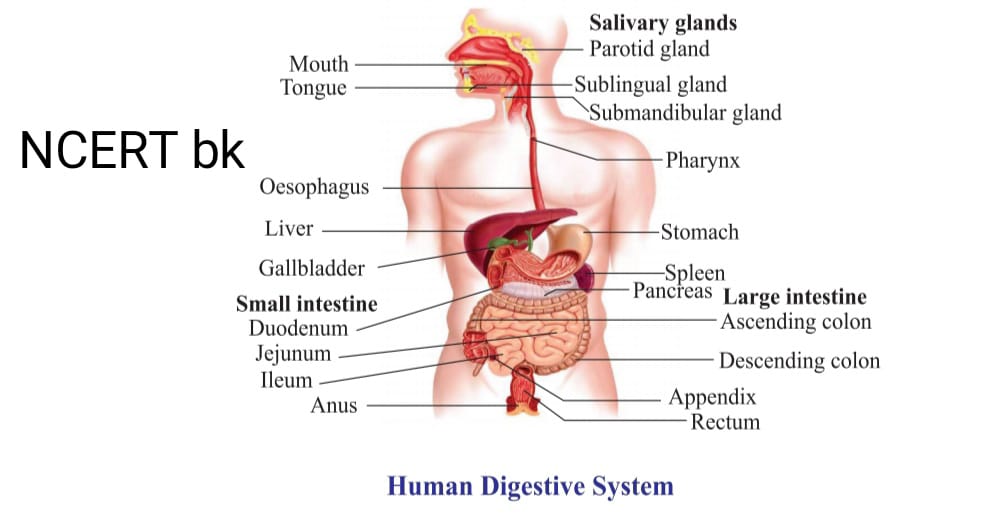
Ingestion. Means food is taken in through mouth.
Digestion. Teeth helps to chew the food taken and grinded
Tongue, It helps in the movement of food, mixed with saliva in Mouth The Salivary gland secrete saliva and mucus saliva contains salivary amylase changes starch to sugar.
Oesophagus. From mouth food is taken to stomach through it by peristaltic movement ie by contraction and expansion of the oesophagus.
Stomach. As food reaches to stomach gastric gland secrete gastric juice which consist pepsin which is protein digestive enzymes, HCl create acidic medium, and mucus protect the inner layer of the stomach.
Digestion. After stomach food reaches in small intestine which have intestinal enzyme which changes carbohydrate to glucose, fats changes into fatty acids and glycerol, protein changes to ammino acid.
Liver secretes bile juice which act as emulsifier for fats, large fat globes changes emulsified into small fat globules.
Pancreas secretes pancreatic juice having trypsin which convert protein into peptones lipase emulsified fats into lipid
Absorption. This also takes place in small intestine which consist of villi that are finger like projection to increase the surface aera for absorption of digestive food into blood.
Assimilation the blood carries absorbed food to all parts of the body where it is utilised for obtain energy, building up new Tissues, repair old tissues.
Egestion takes place in large intestine, the excess of water is absorbed, rest of the unabsorbed food material is removed from body via anus
RESPIRATION IN HUMAN BEING is the process in the living Organism which involves
a. Breathing. It is the exchange of gases ie intake of oxygen and release carbon di oxide that takes place through lung
b. Cellular Respiration. It is the process of breakdown of simple food ie glucose in order to release energy inside the cell this takes place in lungs as well as in mitochondria of cell.
BREAKING DOWN OF GLUCOSE
It is also called cellular respiration. Glucose containing 6 carbon the molecule in cytoplasm breaks into pyruvate having 5carbon molecules and energy This kind of respiration takes place in. 3 steps
a. Absence of oxygen that takes place in yeast that causes fermentation also produces ethanol, carbon di oxide energy and 2 molecules of carbon.
b. Lack of oxygen in molecules produced lactic acid energy and 3molecules of carbon which is caused during cramps.
c. In the presence of oxygen that takes place in mitochondria that produces carbon. Di Oxide, water and energy.
TYPES OF RESPIRATION
Aerobic Respiration: The respiration that takes place in the presence of oxygen that takes place in mitochondria its end products are carbon di oxide, water, and large amount of energy This kind of respiration mostly takes place in plants and animals.
Anaerobic Respiration. The respiration that takes place in the absence of. Oxygen /air that always takes place in cytoplasm. The end products are ethanol/lactic acid, less amount of energy is released that mostly occurs in yeast, muscles, bacteria.
MECHANISM OF RESPIRATION
It consists of two process.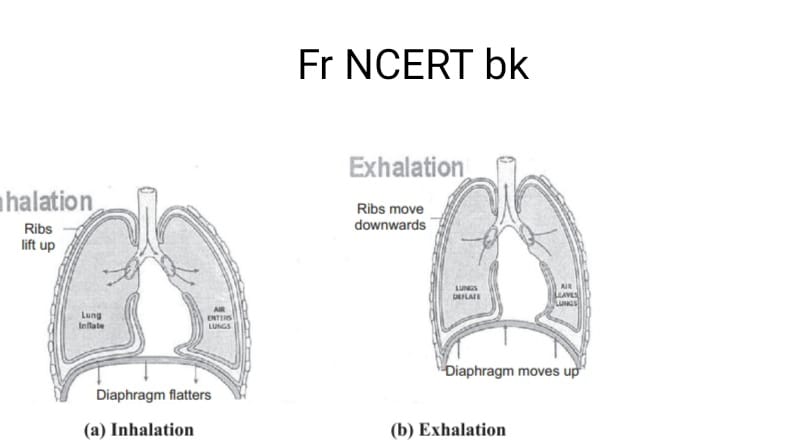
INHALATION: It means to breathe in this rib cage move upward and outward but diaphragm moves downward or become flat so chest cavity becomes large so pressure out side becomes more air is sucked into lungs and expanded alveoli.
EXHALATION: It means breathe out rib cage moves downwards or inwards diaphragm moves upward chest cavity become smaller such that air is pushed out with contract of alveoli.
EXCHANGE OF GASES
Inhalation or Exhalation takes place only by diffusion During inhalation oxygen rich reach to alveolar sac than oxygen is taken up by blood in alveolar blood and oxygen binds with haemoglobin the respiratory pigment in RBC and transport oxygen to all cells in body through blood vessels. During Exhalation carbon di oxide rich blood reaches to alveolar sac and it is released out through nostrils.
RESPIRATION IN PLANTS
In case of terrestrial organism they use atmospheric oxygen for their respiration. The amount of oxygen is more therefore the rate of respiration is low
In case of aquatic organism, they use the oxygen dissolved in water for respiration as amount of oxygen dissolved in water is less therefore rate of breathing is high.
In case of plant gaseous exchange of carbon di oxide and oxygen takes place by diffusion through stomata as large inter cellular spaces
CIRCULATORY SYSTEM
The components of Circulatory system consist of Circulatory medium which are blood, Lymph.
The mechanism of blood circulation takes place through.
a. The pumping organ heart
b. Blood vessels which are in form of Arteries, veins, capillaries
. Lymph: It is colorless fluid, it escapes from blood capillaries into inter cellular space. It contains less protein than blood. Lymph contains digested and absorbed fats from small intestine and it also drain excess of fluid from extracellular space back into blood.
Blood vessels are of three kind
a Arteries which carries oxygenated blood from heart to different organs of the body except pulmonary artery they are thick and elastic they do. not have any valves and flow of blood is with high pressure.
Veins It carry de. Oxygenated blood from different organs of body to the heart except pulmonary vein, they are thin, less elastic and have valves which prevent backward flow of blood with less pressure.
Capillaries It is thin walled and smallest blood vessels which connect arteries into veins. It exchanges mate ridd Lipe food, oxygen, carbon di oxide that takes place between blood and body cells through capillaries.
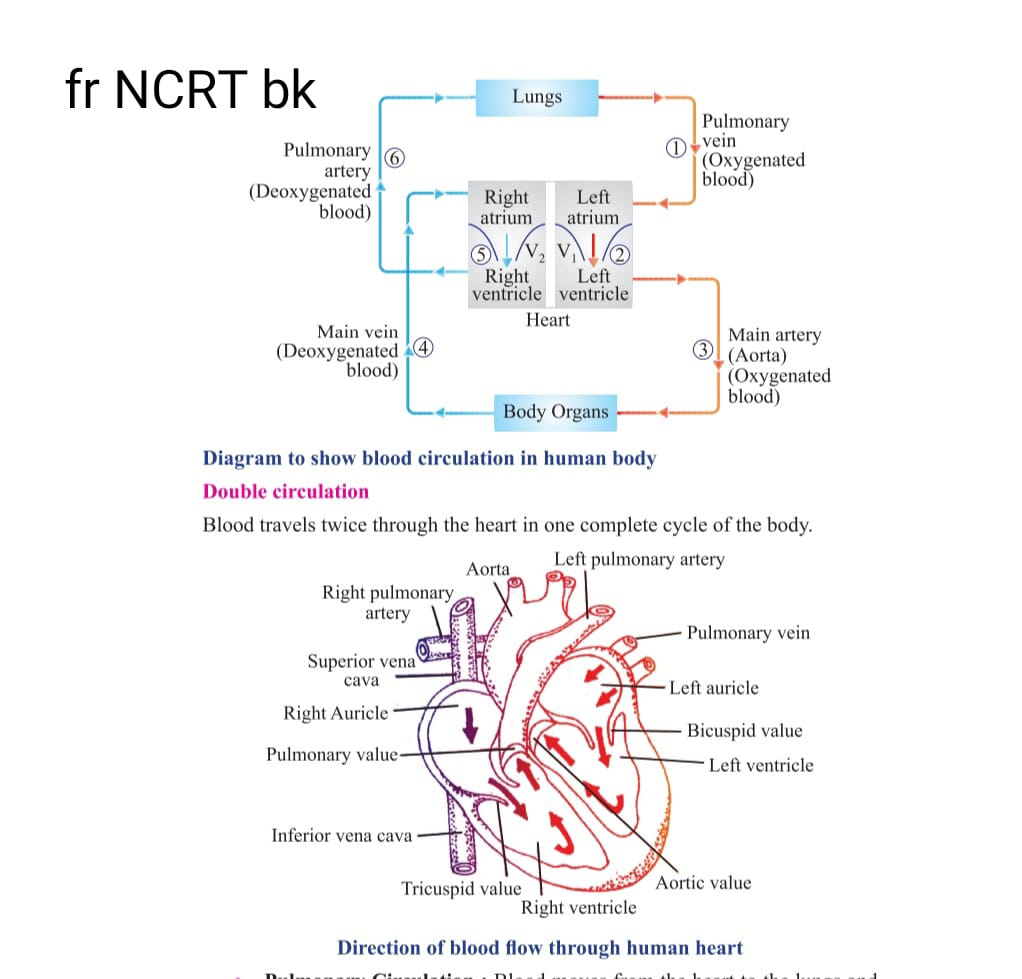
HEART
It is a muscular pumping organ which pumps blood to all parts of body Human heart is four chambered
Right. Atrium. Right Ventricle
Left Atrium. Left Ventricle
These chambers are separated by muscular wall so that oxygenated blood may not mix with de oxygenated blood or rich of carbon di oxide.
Blood circulation in human body start first from lungs when oxygenated blood flows from lungs to heart through pulmonary vein.
From this vein it enters to left atrium which contains Mitral valve as it enters to left ventricle
These chambers are separated by muscular wall so that oxygenated blood may not mix with de oxygenated blood or rich of carbon di oxide.
Blood circulation in human body start first from lungs when oxygenated blood flows from lungs to heart through pulmonary vein.
From this vein it enters to left atrium which contains Mitral valve as it enters to left ventricle
From the left ventricle through artery aorta from aortic valve oxygenated blood is transferred to different organ of the body.
From the different organs de oxygenated blood is taken to heart through main pulmonary vein than enter to right artium than passing through tri cuspid valve it enter in right ventricles
From Right Ventricle this de oxygenated blood is taken to lungs through pulmonary artery
DOUBLE CIRCULATORY SYSTEM
The blood in the body moves twice.
First the oxygenated blood comes from lungs passes through pulmonary vein reaches to left atrium than reaches to left ventricle after that it goes to different organs with the help of arteries after passing through aorta.
Secondly after passing from all organs the de oxygenated blood passes through veins from Vena Cava, it reaches to right atrium than to right ventricle after that goes to lungs through pulmonary artery.
TRANSPORTATION IN PLANTS
XYLEM it carries water and minerals from roots to other parts of the plants. In this no energy is used. On maturity the xylem becomes the dead cells/tissue that gives mechanical support to plants. This is carried out by xylem vessels and tracheid
Phloem it carries product of photosynthesis from leaf to other parts of plants. Energy used in form of ATP it exists in living tissues which takes place in sieve tubes with the help of adjacent companion cells.
Transportation It is the process of loss of water vapors from the aerial parts of plants It helps the absorption and upward movement of water, mineral that helps the regulation of temperature of plants.
Translocation. It is the process transporting food from leaves to other parts of plants. It helps to transport of soluble products of photosynthesis and other substance to other parts of plants and provide food to all parts of plants storage organ to growing organ.
Two chamber heart fish
Three chamber heart. Reptiles, amphibians
Four chamber heart. Mammals, birds, human being.
.
EXCRETION
It is the process of removal of harmful metabolic waste from the body There are three kinds of EXCRETION.
a. The excretion in unicelled organism the waste is removed by simple mode of diffusion.
b. Excretion in human body
c. Excretion in plants
EXCRETION SYSTEM IN HUMAN BODY
a. PAIR OF KIDNEY. It is an excretory organ, the basic filtration unit of kidney is NEPHRON. It helps to form urine and also regulate right amount of water in our body also help infiltering out nitrogenous waste like uera from blood.
b. PAIR. OF URETERS. They are the ducts which drain urine out from kidney to urinary bladder. It is long which collect urine from kidney. The main function of NEPHRON is the excretion of nitrogenous waste and maintain the water and ionic balance which is also called Osmic regulation.
URINE FORMATION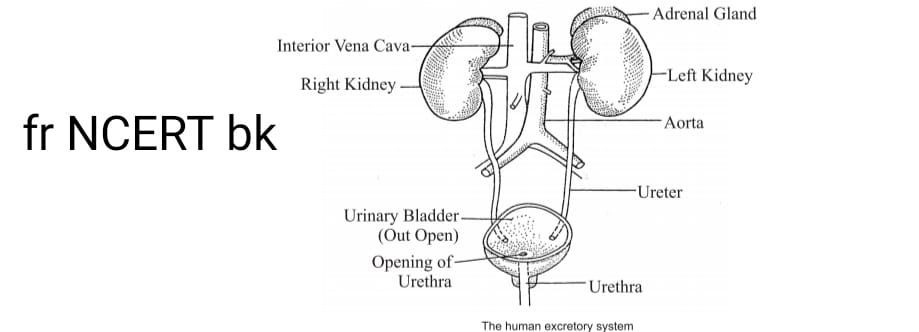 Glomerular filtration: In this Nitrogenous waste glucose, water, amino acids, filter from blood in Bowman’s capsule
Glomerular filtration: In this Nitrogenous waste glucose, water, amino acids, filter from blood in Bowman’s capsule
Tubular Re Absorption: In these useful substances from the filtered are absorbed back by capillaries surrounding NEPHRON.
Secretion: Uera, extra water, are secreted into the tubular which open in a ducts collecting and goes to ureter
Urine production is regulated by amount of excess of water and amount of dissolved waste that is needed to be excreted.
HAEMODIALYSIS: It is the process of purifying blood by artificial kidney incase of kidney failure.
URINARY BLADDER: which is urinary reservoir it store urine it is passed out It is muscular to control the urge to urine
URETHRA. Channel to take urine to exterior of body.
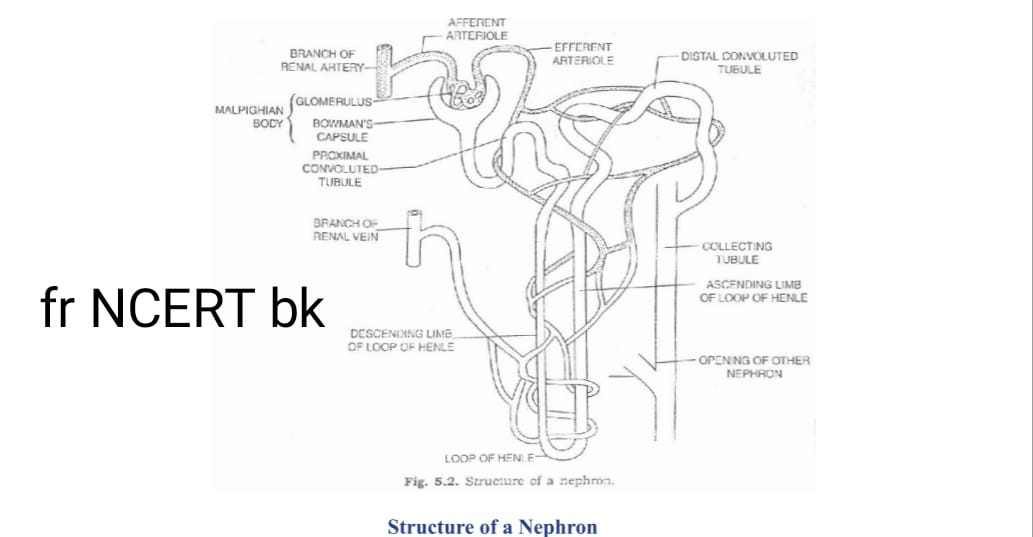
HUMAN. EXCRETION
Blood is filtered through capillary, cluster, glomerulus into the NEPHRON of the kidney. This filtrate gets collected in Bowman capsule. The filtrate flows along the NEPHRON tube his filtrate gets collected in Bowman capsule. The filtrate flows along the NEPHRON tube and the substance like glucose, amino acids, salts and excess of water are absorbed to form urine. It flow through ureter into urinary bladder where it is stored explosion through urethra.
NEPHRON; it is made up of thin-walled capillaries called glomerulus which are associated cup like structure called Bowman Capsule and long collecting tube which terminates through this capsule
,EXCRETION IN PLANTS
a gaseous waste like oxygen, carbon di oxide, are removed through stomata by diffusion
b. Excess of water is removed by transpiration
c some waste are stored in leaves that fall
d. Some waste is stored in rasin and gum or cell vacuoles
e. Some waste is released in surrounding soil.
Follow us on: Instagram
Follow us on :Facebook
Read More : Control and Co ordination
Read More : How do organism Reproduce